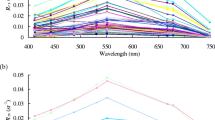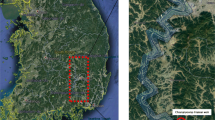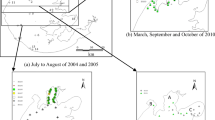Abstract
An improved three-band semi-analytical algorithm was developed for improving the performance of the three- and four-band algorithms, for chlorophyll-a concentration retrievals in the highly turbid waters of the Yellow River estuary. In this special case study of the Yellow River estuary, the optimal wavelengths of the improved three-band semi-analytical algorithm must meet the following requirements: the λ 1 and λ 2 must be restricted to within the range 660–690 nm, and the λ 3 must be longer than 750 nm. The algorithm calibration and validation results indicate that the improved three-band algorithm indeed produces superior performance in comparison to both the three- and four-band algorithms in retrieving chlorophyll-a concentration from the extremely coastal waters of the Yellow River estuary. Comparing the improved three-band algorithm to the original three- and four-band algorithm, the former minimizes the influence of backscattering by suspended solids in near-infrared regions, while the three-band algorithm has a much stronger error tolerance ability than the four-band algorithm. These findings imply that if an atmospheric correction scheme for visible and near-infrared bands is available, the improved three-band algorithm may be used for quantitative monitoring of chlorophyll-a concentration in turbid coastal waters with similar bio-optical properties, although some local bio-optical information or improved models may be required to reposition the optimal band positions of the algorithm.








Similar content being viewed by others
References
ASD (1999). Analytic Spectral Devices. Inc. Technical Guide, 3rd Ed
Babin M, Stranski D (2004) Variations in the mass-specific absorption coeffcient of mineral particles suspended in water. Limnol Oceanogr 49(3):756–767
Binding CE, Jerome JH, Bukata RP, Booty WG (2008) Spectral absorption properties of dissolved and particulate matter in Lake Erie. Remote Sens Environ 112:1702–1711
Carder KL, Chen FR, Lee ZP, Hawes SK, Cannizzaro JP (2003) MODIS Ocean Science Team Algorithm Theoretical Basis Document: Case 2 chlorophyll a. ATBD 19, Version 7
Chen J, Quan WT (2012) An improved algorithm for retrieving chlorophyll-a from the Yellow River Estuary using MODIS imagery. Environ Monit Assess. doi:10.1007/s10661-10012-12705-y
Chen JX, Yu CH, Jin L (2003) Mathematical analysis, 4th edn. Higher Education Press, Beijing
Chen J, Zhou GH, Wen JG, Fu J (2010a) Effect of remotely sensed data errors on the retrieving accuracy of territorial parameters. Spectrosc Spectr Anal 30(5):1347–1350
Chen XL, Lu JZ, Cui TW, Jiang WS, Tian LQ, Chen LQ, Zhao WJ (2010b) Coupling remote sensing retrieval with numerical simulation for SPM study-Taking Bohai Sea in China as a case. Int J Appl Earth Obs Geoinf 12S:S203–S211
Chen J, Fu J, Zhang MW (2011a) An atmospheric correction algorithm for Landsat/TM imagery basing on inverse distance spatial interpolation algorithm: a case study in Taihu Lake. J Sel Appl Earth Observ Remote Sens. doi:10.1109/JSTARS.2011.2150200
Chen J, Wen ZH, Fu J, Sun JH, Wang BJ, Gao XJ (2011b) The application and principle of water quality remote sensing, vol 1. Ocean Press, Beijing
Dall’Olmo G, Gitelson AA (2006) Effect of bio-optical parameter variability and uncertainties in reflectance measurements on the remote estimation of chlorophyll-a concentration in turbid productive waters: modeling results. Appl Opt 45(15):3577–3592
Dall’Olmo G, Gitelson AA, Rundquist DC (2003) Towards a unified approach for remote estimation of chlorophyll-a in both terrestrial vegetation and turbid productive water. Geophys Res Lett 30. doi:10.1029/2003GL0108065
Deng M, Li Y (2003) Use of SeaWiFS imagery to detect three-dimensional distribution of suspended sediment. Int J Remote Sens 24(3):519–534
Doxaran D, Froidefond JM, Lavender S, Castaing P (2002) Spectral signature of highly turbid water application with SPOT data to quantify suspended particulate matter concentration. Remote Sens Environ 81(1):149–161
Gilpin L, Tett P (2001) A methods for analysis of benthic chlorophyll-a pigment. In: Marine biology report. Napier University Press, UK, pp 326–341
Gitelson AA (1992) The peak near 700 nm on reflectnce spectra of algae and water: relationships of its magnitude and position with chlorophyll concentration. Int J Remote Sens 13:3367–3373
Gitelson AA, Schalles JF, Hladik CM (2007) Remote chlorophyll-a retrieval in turbid, productive estuaries: chesapeake Bay case study. Remote Sens Environ 109:464–472
Gitelson AA, Dall’Olmo G, Moses W, Rundquist DC, Barrow T, Fisher TR, Gurlin D, Holz J (2008) A simple semi-analytical model for remote estimation of chlorophyll-a in turbid waters: validation. Remote Sens Environ 112:3582–3593
Gons HJ, Rijkeboer M, Bagheri S, Ruddick KG (2000) Optical Teledection of chlorophyll a in Estuarine and Coastal Waters. Environ Sci Technol 34:5189–5192
Gons HJ, Auer MT, Effler SW (2008) MERIS satellite chlorophyll mapping of oligotrophic and eutrophic waters in the Laurentian Great Lakes. Remote Sens Environ 112:4098–4106
Gordon HR (1990) Radiometric considerations for ocean color remote sensing. Appl Opt 29:3228–3236
Gordon HR, Voss KJ (1999) MODIS normalized water-leaving radiance algorithm theoretical basis document. NASA Technic Document, Under Contract Number NAS5-31363, Version 31364
Gordon HR, Brown OB, Evans RH, Brown JW, Smith RC, Baker KS, Clark DK (1988) A semianalytic radiance model of ocean color. J Geophys Res 93:10909–10924
Hale GM, Querry MR (1973) Optical constants of water in the 200 nm to 200 micrometer meter wavelength region. Appl Opt 12(3):555–563
Hu CM, Carder KL (2002) Atmospheric correction for airborne sensors: comment on a scheme used for CASI. Remote Sens Environ 79:134–137
Le CF, Li YM, Zha Y, Sun DY, Huang CC, Lu H (2009) A four-band semi-analytical model for estimating chlorophyll a in highly turbid lakes: the case of Taihu Lake, China. Remote Sens Environ 113:1175–1182
Lee ZP, Carder KL (2004) Absorption spectrum of phytoplankton pigments derived from hyperspectral remote-sensing reflectance. Remote Sens Environ 89(3):361–368
Lee ZP, Carder KL, Hawes SH, Steward RG, Peacock TG, Davis CO (1994) A model for interpretation of hyperspectral remote sensing reflectance. Appl Opt 33:5721–5732
Lee ZP, Carder KL, Mobley CD, Steward RG, Patch JS (1999) Hyperspectral remote sensing for shallow waters. 2. Deriving bottom depths and water properties by optimization. Appl Opt 38:3831–3843
Lee ZP, Carder KL, Arnone RA (2002) Deriving inherent optical properties from water color: a multiband quasi-analytical algorithm for optically deep waters. Appl Opt 41(27):5755–5772
Matthews MW (2011) A current review of empirical procedures of remote sensing in inland and near-coastal transitional waters. Int J Remote Sens 32(21):6855–6899
Mobley CD (1994) Light and water: radiative transfer in natural waters. Academic Press, New York
Moore TS, Campbell JW, Dowell MD (2009) A class-based approach to characterizing and mapping the uncertainty of the MODIS ocean chlorophyll product. Remote Sens Environ 113:2424–2430
Morel A, Gentili B (1993) Diffuse reflectance of oceanic waters, II, Bi-directional aspects. Appl Optical 30:4427–4438
Morel A, Gentili B (1996) Diffuse reflectance of oceanic waters. III. Implication of bidirectionality for the remote sensing problem. Appl Opt 35(24):4850–4613
Morel A, Prieur L (1977) Analysis of variances in ocean color. Limnol Oceanogr 22:709–722
Mueller JL, Fargion GS (2002). Ocean optics protocols for satellite ocean color sensor validation. SeaWiFS Technical Report Series, Revision 3 Part II, pp 171–179
Mueller JL, Davis CO, Arnone RA, Frouin R, Carder KL, Lee ZP, Steward RG, Hooker S, Mobley CD, McClain CR (2003) Above-water radiance and remote sensing measurement and analysis protocols. Ocean Optics Protocols for Satellite Ocean-Color Sensor Validation, Revision 4, Vol. III: Radiometric Measurements and Data Analysis Protocols, NASA Tech. Memo, pp 2003–21162
O’Reilly JE, Maritorena S, Mitchell BG, Siegcl DA, Carder KL, Garver SA, Kahru M, McClain C (1998) Ocean color chlorophyll algorithms for SeaWiFS. J Geophys Res 103(11):937–953
Ouaidrari H, Vermote EF (1999) Operational atmospheric correction of Landsat TM data. Remote Sens Environ 70:4–15
Qiao SQ, Shi XF, Zhu AM, Liu YG, Bi NS, Fang XS, Yang G (2009) Distribution and transport of suspended sediments off the Yellow River mounth and the nearby Bohai Sea. Estuar Coast Shelf Sci. doi:10.1016/j.ecss.2009.1007.1019
Ruddick KG, Ovidio F, Rijkeboer M (2000) Atmospheric correction of SeaWiFS imagery for turbid coastal and inland waters. Appl Opt 39:897–912
Tachiiri K (2005) Calculating NDVI for NOAA/AVHRR data after atmospheric correction for extensive images using 6S code: a case study in the Marsabit District, Kenya. ISPRS J Photogrammetry Remote Sensign 59:103–114
Tassan S, Ferrari GM (2003) Variability of light absorption by aquatic particles in the near-infrared spectral region. Appl Opt 42:4802–4810
Tzitzuiou M, Herman JR, Gallegos CL, Neale PJ, Subramanian A, Harding LW, Ahmad Z (2006) Determination of chlorophyll contentand tropic state of lakes using field spectrometer and IRS-IC satellite data in the Mecklenburg Lake Distract, Germany. Remote Sens Environ 73:227–235
Walden AT (1990) Variance and degrees of freedom of a spectral estimator following data tapering and spectral smoothing. Signal Process 20:67–79
Wang MH, Son SH, Shi W (2009) Evaluation of MODIS SWIR and NIR-SWIR atmospheric correction algorithms using SeaBASS data. Remote Sens Environ 113:635–644
Zhang MW, Tang JW, Dong Q, Song QT, D J (2010) Retrieval of total suspended matter concentration in the Yellow and East China Seas from MODIS imagery. Remote Sens Environ 114:392–403
Acknowledgments
This study is supported by the Science Foundation for 100 Excellent Youth Geological Scholars of China Geological Survey, open fund of Key Laboratory of Marine Hydrocarbon Resources and Environmental Geology (MRE201109), High-tech Research and Development Program of China (No. 2007AA092102), and Dragon 3 Project (ID 10470). We would like to just express our gratitude to two anonymous reviewers for their useful comments and suggestions.
Author information
Authors and Affiliations
Corresponding author
Rights and permissions
About this article
Cite this article
Chen, J., Quan, W., Wen, Z. et al. An improved three-band semi-analytical algorithm for estimating chlorophyll-a concentration in highly turbid coastal waters: a case study of the Yellow River estuary, China. Environ Earth Sci 69, 2709–2719 (2013). https://doi.org/10.1007/s12665-012-2093-1
Received:
Accepted:
Published:
Issue Date:
DOI: https://doi.org/10.1007/s12665-012-2093-1




